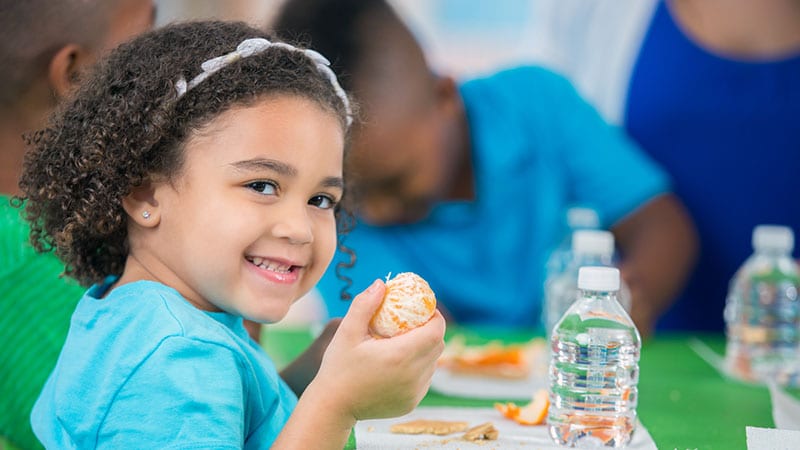Establishing healthy eating habits is critical for kids (and teachers!). It helps keep them focused, sleep better and learn and achieve in the classroom. Looking for some fun ways to add it to your classroom curriculum? Try these ideas.
- Give them food for thought. Most kids think of food as either “good” or “bad” for you. Help them identify food as fuel instead. Just like a car needs gas to go, our bodies need food to think, play and move. When we fill up our “tanks” with healthy food options, our energy levels soar and our brains are ready to work. Get more ideas here.
- Eat this, not that. You are what you eat, so give kids plenty of information about healthy food choices. For example, show them that the most nutritious foods have the least number of ingredients (fruit, vegetables, whole grains). Demonstrate how to make a healthy plate with this free printable or try this fun puzzle board.

- Rethink their drinks. So many of our so-called “kid-friendly” drinks are loaded with extra sugar. Just one sweetened 8 oz. glass adds up to over 20 pounds of sugar in one year! Remind students that the healthiest drinks are water and low-fat milk. Use these resources to help kids find the difference between healthy and unhealthy drink options.

- Show where healthy food comes from. Take a field trip to a farmer’s market or a dairy farm and have the students meet the people who grow healthy food. If the farmers allow, let them pick and taste test the crops, or try milking a cow to see where our dairy products come from. Extra credit if you take your learnings back to school and try growing your own veggie plants!
- But first, breakfast. Mornings are the perfect time to kick start your bodies with nutrients, but 58% of Americans don’t eat the most important meal of the day. Encourage students to make breakfast part of their morning routine and choose healthy options that will get their day off to a great start. Watch this slideshow for healthy alternatives to breakfast barriers, like not enough time, food shortages or sleeping too late.

- Nutrition label know-how. Show students how to read a nutrition label, pointing out where to find carbohydrates and fat content as well as the number of calories and sugar. Have them bring in various nutrition labels from home and see if they can figure out which foods are the healthiest.
- Get your read on. There are tons of great children’s titles out there about healthy eating. Classics such as Gregory, the Terrible Eater or Green Eggs and Ham are great to read aloud for your younger grades. Other fun books like The Boy Who Loved Broccoli or How Did That Get in My Lunchbox? The Story of Food can spark some conversation about where our food comes from.
- Talk about portion sizes. Help kids understand that the amount of food on our plates is just as important as the foods that are on it. Teach them that a portion is the “right amount of food for our bodies.” Visualize the proper portion sizes with familiar objects, like a baseball or a deck of cards using this printout. We also love this portion-size plate tool from WebMD.
- Have a cooking demonstration. Find a healthy snack or recipe to share and prepare it in front of the kids—they’ll love having a teacher “cook” for them and will really love the part about eating it afterwards! Try fruit smoothies, trail mix, yogurt parfaits, veggie wraps or berry popsicles.
- Make healthy eating a game! Play Red Light, Green Light: Healthy Food Edition outside by calling out a name of a food and have kids go fast if it’s healthy; slow down if it’s so-so; and stop if it’s an unhealthy choice. You can supplement with this printable in the classroom. Another game is the “Yay or Nay” game. Have students cut out pictures of foods from grocery store catalogs or magazines, or bring in food wrappers from home, and make a chart by gluing healthy foods on one side and poor choices on the other.


